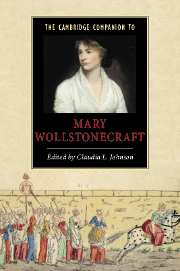Book contents
- Frontmatter
- 1 Introduction
- 2 Mary Wollstonecraft's letters
- 3 Mary Wollstonecraft on education
- 4 Mary Wollstonecraft's Vindications and their political tradition
- 5 Mary Wollstonecraft's French Revolution
- 6 Mary Wollstonecraft's literary reviews
- 7 The religious foundations of Mary Wollstonecraft's feminism
- 8 Mary Wollstonecraft and the literature of advice and instruction
- 9 Mary Wollstonecraft's A Vindication of the Rights of Woman and the women writers of her day
- 10 Mary Wollstonecraft and the poets
- 11 Mary Wollstonecraft's novels
- 12 Letters Written During a Short Residence in Sweden, Norway, and Denmark: traveling with Mary Wollstonecraft
- 13 Mary Wollstonecraft and the sexuality of genius
- 14 Mary Wollstonecraft's reception and legacies
- Select bibliography
- Index
2 - Mary Wollstonecraft's letters
Published online by Cambridge University Press: 28 May 2006
- Frontmatter
- 1 Introduction
- 2 Mary Wollstonecraft's letters
- 3 Mary Wollstonecraft on education
- 4 Mary Wollstonecraft's Vindications and their political tradition
- 5 Mary Wollstonecraft's French Revolution
- 6 Mary Wollstonecraft's literary reviews
- 7 The religious foundations of Mary Wollstonecraft's feminism
- 8 Mary Wollstonecraft and the literature of advice and instruction
- 9 Mary Wollstonecraft's A Vindication of the Rights of Woman and the women writers of her day
- 10 Mary Wollstonecraft and the poets
- 11 Mary Wollstonecraft's novels
- 12 Letters Written During a Short Residence in Sweden, Norway, and Denmark: traveling with Mary Wollstonecraft
- 13 Mary Wollstonecraft and the sexuality of genius
- 14 Mary Wollstonecraft's reception and legacies
- Select bibliography
- Index
Summary
Mary Wollstonecraft is one of the most distinctive letter writers of the eighteenth century. Her works from her juvenile productions as a young girl in the Yorkshire town of Beverley to her final notes to her husband and future biographer William Godwin are instantly recognizable. Indeed Wollstonecraft's value is as much in letter writing as in public authorship; often she seems almost to live through her correspondence, expressing within it her numerous roles: child, daughter, companion, friend, teacher, governess, sister, literary hack, woman of letters, lover, wife, rationalist, and romantic. She wrote incessantly throughout her life, priding herself on her frank expression and often berating her correspondents for not rising to her expansive standards. She might have said with Amelia Opie, a friend from her final years, “If writing were an effort to me I should not now be alive . . . and it might have been inserted in the bills of mortality – 'dead of letter writing A. Opie.'”
Wollstonecraft’s letters were self-aware certainly but they were also dashed off as the overflow sometimes of joy, more often of bitterness, ennui, and self pity. They are occasionally funny, often engaging, but most frequently moving in their self-centered vulnerability. In them Wollstonecraft grows from the awkward child of fourteen to the woman of thirty-eight facing her death in childbirth. One can see where she matured and where she remained entangled in childhood emotions, noting in the swift reading of a lifetime’s writing the unity in temperament from beginning to end, the eerie consistency of tone.
- Type
- Chapter
- Information
- The Cambridge Companion to Mary Wollstonecraft , pp. 7 - 23Publisher: Cambridge University PressPrint publication year: 2002
- 4
- Cited by



